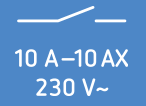
Brochure: The best way to switch and dim LED lighting
Capacitive switching loads: Hard work for the contacts
A simple scenario: in the staircases of a large residential building, the building management replaces the light bulbs with LED retrofit lamps. A specialist measures and verifies the prescribed brightness. The potential for savings is promising: next to the more favourable energy consumption, the long service live should also ensure for less maintenance costs. But suddenly the staircase light timer switch fails. An examination had shown scorched or fused contacts: the devices were obviously overloaded although the rated output of the installation was reduced significantly.
You can find out about dimming LEDs infinitely and flicker-free on the following pages.

Capacitive switching loads: Hard work for the contactsHow can an LED lamp that only has a few Watt rated output destroy a switching contact that has been dimensioned for a multiple thereof? Upon closer inspection, the answer is found in the switching currents Capacitive switching loads |

Two contacts for all switching cases: Tungsten pre-contactHigh currents require special contacts. Next to silver tin oxide (AgSnO2), Theben uses a combination of two contacts that close after one-another: the tungsten pre-contact. Tungsten pre-contact protects LED lamps |

Zero-cross switching: Switching precisely at a poinSwitching devices that are designed for a C load generally deal with the switching currents in a better manner. In doing so, Theben uses a particularly efficient solution, such as a so-called zero-cross switching. This calculates the zero crossing of the sinus curve of the alternating voltage. At this moment, the switch-on current is minimum when switching. That protects the relay contact and extends its service life, even at nominally high switching loads. Zero-cross switching preserves relays |

Theben uses cadmium-free contacts made from AgSnO2 materialsCadmium oxide was thought to have been the ideal contact material for high switching currents. In the meantime, it is forbidden according to the RoHS guideline - where there are exceptions for electrical switching contacts. Theben had already changed to the environmentally friendly AgSnO2 material at the turn of the millennium. Cadmium-free contacts made from AgSnO2 materials |

